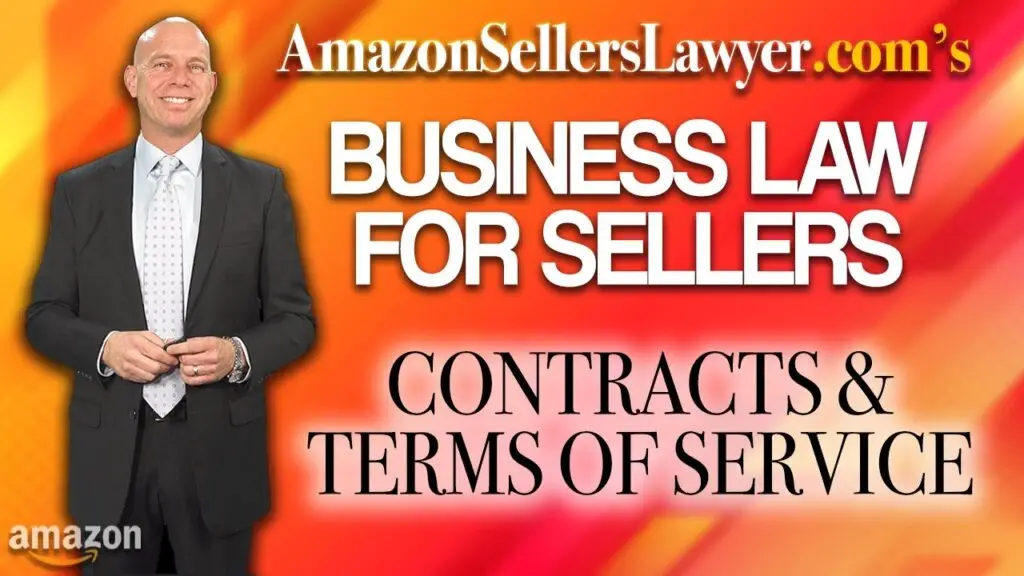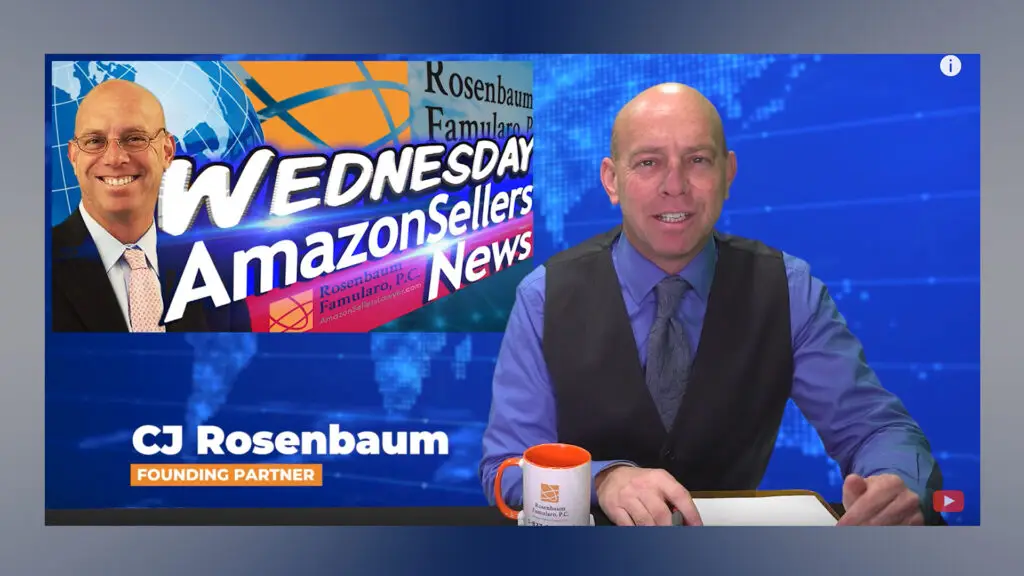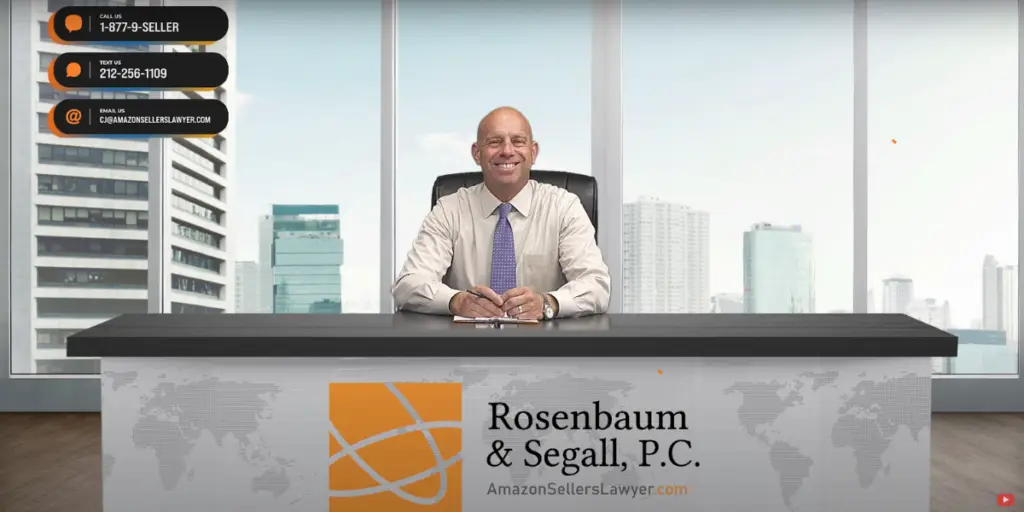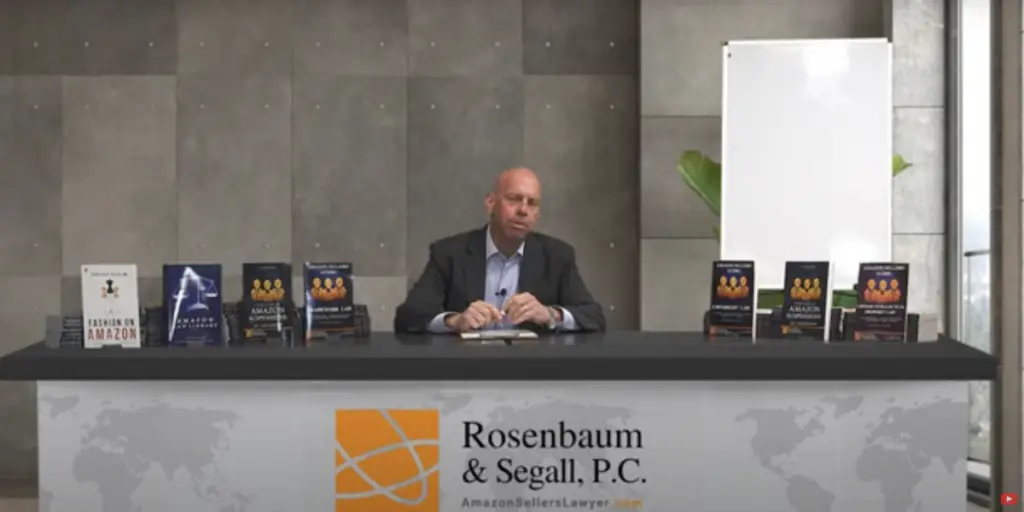Amazon Terms of Service
Amazon’s New Terms of Service (TOS) Explained: New Contract with Sellers

What Amazon Sellers Need to Know About the Terms Of Service
Understanding Amazon’s Business Solutions Agreement (BSA) is crucial for sellers to protect their accounts and revenue. At Amazon Sellers Lawyer, we help sellers navigate policy changes, fight wrongful suspensions, and ensure compliance with Amazon’s evolving terms. In the new Terms of Service that Amazon imposed on all Amazon sellers, Amazon promised sellers that they would give a 30 day notice before an account suspension or listing suspension would occur. Find out what these loopholes are by watching our videos below. Amazon’s TOS includes strict policies regarding:
- Account Verification & Suspensions – New rules make it easier for Amazon to suspend accounts without warning.
- Withheld Funds & Inventory Seizure – Amazon can hold your money and products indefinitely if they suspect violations.
- Intellectual Property & Brand Registry – Misuse of trademarks or failure to respond to IP complaints can lead to permanent bans.
Amazon Terms of Service Explained: General Terms for Plans of Action
Amazon sellers around the world need to know that Amazon instituted a new contract on sellers. There are significant changes to the new agreement that they are imposing on you. Some provisions are really helpful and good for sellers. While others are absolutely awful. Some will help us write better Plans of Action and appeals for suspended sellers who need help getting their listings and accounts back. If you are writing a Plan of Action yourself or you are having someone else write a Plan of Action for you, they should know this new contract inside and out. They should be able to interpret it. They must understand the legal terms or you are paying for expertise that you are not getting. Whoever writes your appeal should understand the legal terminologies and the effects of the new contractual provisions.
Amazon Terms of Service Explained: Paragraph 1: Business Verification
Amazon seller suspensions, Plans of Action, and appeals for business verification suspensions have changed under Amazon’s new contract. The issue for suspended sellers in this paragraph is business verification. Amazon business verification is where Amazon suspends your account because of Amazon’s inability to verify your information, your credit cards, your identification, or your utility bills.
Amazon Terms of Service Explained: Paragraph 2: Service Fee Payments
TOS Explained: the 2nd paragraph in the new business solutions agreement -which most sellers don’t realize is their contract with AMZ. When it comes to the second paragraph in the business solutions agreement, what is ‘velocity limits’ and what is your concern with this new contract? The second paragraph of the BSA basically allows Amazon to hold your money for any reason at all (without explanation).
Terms of Service: Paragraph 3A: 30 Day Notices & Suspensions
Amazon’s New TOS Terms of Service & 30 Day Suspension Notice. The TOS is contained in the contract Amazon imposes on all Sellers which is called the Business Solutions Agreement. The 30 Day Notice Provision…and its HUGE Loopholes are contained in Paragraph 3. Amazon’s Latest Language in the Amazon Sellers Terms of Service / TOS / Participation Agreement (which is actually called the Business Solutions Agreement). What is the agreement called between Amazon Sellers and Amazon? Terms of Service? TOS?
Terms of Service: Paragraph 3B: Suspended Accounts & Listings
The third paragraph of the new Participation Agreement discusses how Amazon account suspensions will now be handled moving forward. As far as the language goes, it seems better than it actually is. Some significant improvements have been laid out by Amazon for their sellers. 30 Day Suspension Notices In the new Amazon Terms of Service (TOS), sellers are given a convenient 30 day advance notice before any account suspension is handed down.
Terms of Service: Paragraph 3C: 30 Day Notice Before Suspension
In the new Terms of Service that Amazon imposed on all Amazon sellers, Amazon promised their sellers that it would give a 30 day notice before an account suspension or Amazon listing suspension would occur. However, Amazon created three huge loopholes that are so broad that we broke this portion of our videos on the new terms of service into three separate sections: loophole A, loophole B, and loophole C. In the new terms of service which is also called the Business Solutions Agreement, Amazon is getting around this well-publicized 30 day notice.
Amazon Terms of Service Explained: Paragraph 4: Private Label Sellers
The Business Solutions Agreement (BSA) is your contract with Amazon as an Amz seller. Many sellers do not even know it exists. It used to be hidden in the definition section when you signed up for Amazon. It states that you should be responsible for learning and understanding whatever changes Amazon imposes upon you. Paragraph 4 of the new BSA talks about licenses and intellectual property rights.

TOS: Paragraph 5 & 6: Representations & Indemnification
It is really important that sellers realize that the change in the language of section 5 expands and broadens the scope of a seller. It originally used to use language such as “You” to specifically identify you, the third party seller. Now it’s referring to you and the entity that you’re associated with as a whole. Now, it’s not just about the representations you make to Amazon, but it’s about the representations the entity makes as a whole.

Amazon Terms of Service Explained: Paragraph 7A: Disclaimer & General Release
Amazon is an ecommerce giant. They have dominated the industry for so many years. This made them realize that they are exposed to more claims and liabilities as their company grows. Thus, they made sure all measures are in place to protect their interests. Just recently, they have made changes to their TOS. However, it can be noted that Paragraph 7 remains unchanged.

Amazon Terms of Service Explained: Paragraph 7B: IP Rights Owner Complaint Dispute
Amazon is one of the biggest online selling platforms. They deal with millions of transactions daily. Thus, disputes among parties involved in these transactions can never really be prevented. This section basically states that if any sort of dispute arises between more than one participant (Seller A vs. Seller B, or Seller vs. Buyer), each participant releases Amazon of all liability.
Amazon Terms of Service Explained: Paragraph 8: Amazon Placing Liability on Third Party Sellers
In the Business Solutions Agreement, section eight, titled Limitation of Liability, was not changed in the slightest. Amazon kept this section entirely the same as it was in the previous BSA. Essentially, what it says is that they will not be liable whether in contract, warranty, tort, to you or any other person for pretty much any reason they bring up in contract, warranty, tort, negligence, or product liability.
Amazon Terms of Service Explained: Paragraph 11&14: Transaction Info Confidentiality Anti Trust
Amazon is very adept at changing their contracts constantly in a way that protects Amazon from liability. So, as we’re going through it paragraph by paragraph in the agreement, as a whole, we saw the entire thing was deleted – and there’s no way Amazon was giving up an entire paragraph of anything. Instead, they seem to have consolidated it. So let’s start with what was crossed out in 14 and then we’ll go back to how it’s been beefed up in paragraph 11.
Amazon Terms of Service Explained: Paragraph 12: Force Majeure
Today I want to talk about one of the shorter provisions which are found in paragraph 12 which is referred to as the force majeure clause. Force majeure is just a fancy way of saying superior or intervening force and it’s actually a contract term that refers to events that are outside of the control of the party.

Amazon Terms of Service Explained: Paragraph 13: Relationship of Parties
Section 13 goes to define the relationship between parties. There were no changes made to this segment. However, I’m still going to go ahead and define what it means for sellers. So essentially, by entering into this service agreement, you are now engaging as an independent contractor. You’re not employed by Amazon, you’re responsible for your own taxes, and you’re simply providing a service under a contract.

Terms of Service: Paragraph 14: Suggestions & Other Information
Section 14 is suggestions and other information. There were no changes in the preexisting BSA from then to now, but I will go ahead and define what this section means. This section essentially states if you or your affiliates elect to provide or make available suggestions, comments, ideas, improvements, or other feedback or materials to use in connection with Amazon services, Amazon has the right to do whatever they want with it. They can go ahead and use it, they can market it, they can disclose it to another individual. So any potential improvements or suggestions or ideas you present to Amazon, things you might think might make them make their system more fluid, they have the right to do whatever they want with that information. So sellers should be aware of this before giving them any such advice or suggestions on services. In addition, Amazon states that in cooperation with any governmental agency, potential lawsuits, they have the right to disclose such information as well as the information contained by the sellers in their system. Essentially, that’s all that encumbers section 14.
TOS: Paragraph 14: How Sellers Should Be Wary What They Post
There were no changes to the BSA in this section. This section essentially states if you or your affiliates elect to provide or make available suggestions, comments, ideas, improvements, feedback or materials to use in connection with Amazon services, Amazon has the right to do whatever they want with it. They can go ahead and use the information, they can market it, they can disclose it to another individual.
TOS: Paragraph 16: How Related Account Suspensions Can Occur
What this section is saying is that the seller is always responsible for their password to their account. You are only allowed to give out your password if a third party is authorized, and you are solely responsible for any action taken under your account. So pretty much, Amazon won’t be taking the blame if someone gains access to your account – if it’s accidental or intentional.
Amazon Terms of Service Explained: Paragraph 16: Password Security
This paragraph has not changed substantially at all, but it is definitely important for sellers to know how Amazon treats security issues because as part of the arbitration team, I’ve seen several sellers who are unfortunately victims of hacked accounts, and we’ve seen how Amazon treats these situations. However, the new contract where the contract states that sellers are the ones solely responsible for maintaining their password security. So once again, Amazon is excusing itself from any liability to protect sellers.
Terms of Service: Paragraph 17: Importance of Abiding by the Law
This section of the agreement hasn’t changed, but we do want to give sellers some tips to better understand this specific agreement section, and to ensure that they don’t run into similar problems. This is probably a section that will not really ever be updated. What it’s saying is that as a seller, you cannot violate United States embargoes. For those of you that don’t know what that is, it’s just a ban on exporting goods to certain countries.
Terms of Service: Paragraph 18: Changes to Expedited Arbitration
One of the most important features of the arbitration process is that it’s supposed to be fast and efficient. Both cost-wise and time-wise for sellers. Amazon’s new contract is trying to take that away from the arbitration process. What I mean by that is there’s something called expedited arbitration.
Amazon Terms of Service Explained: Paragraph F4: Compensation & Moving Inventory
Moving forward, Amazon will not reimburse you if you are an FBA user and your products are damaged or your inventory is lost. They will, however, compensate you. When you think of compensation, that could be anything. Amazon has changed the language. If we know anything, Amazon changes the language to protect itself. Reimbursement always seemed to be the cost of it. There was a whole provision in place that you would get reimbursed the sale price, less FBA fees.
Amazon Terms of Service Explained: S6: How Gaining Control of Listings is Problematic
So originally, this section was about control of Amazon’s sites, but it has recently been changed to Amazon’s website and services. So we do think some sellers will run into issues with this portion of the document being a little bit too vague and open to interpretation. It could be very misunderstood. It’s not really clear what Amazon is requesting. It almost seems like Amazon is going to give sellers more control over the listing page. So the way that it’s worded makes Amazon insinuate that they will be giving sellers more control, but it also looks like they will be able to remove and suspend any access.
Why Choose Amazon Sellers Lawyer?
- Experiences Team: Our attorneys focus on Amazon seller account reinstatements.
- Proven Success Rate: Thousands of sellers have regained their accounts with our help.
- Fast & Effective Appeals: Time is money—we work quickly to resolve your suspension.

